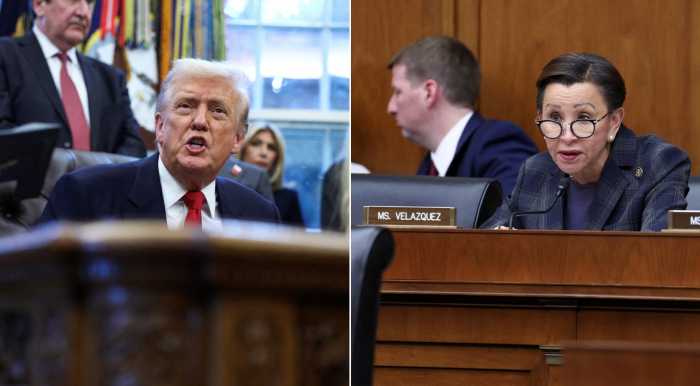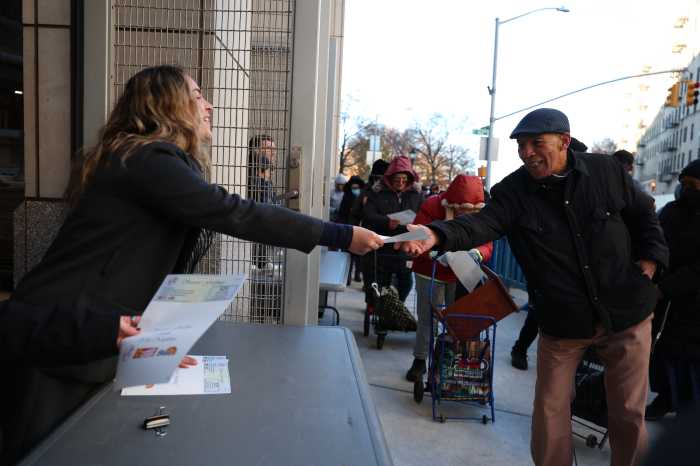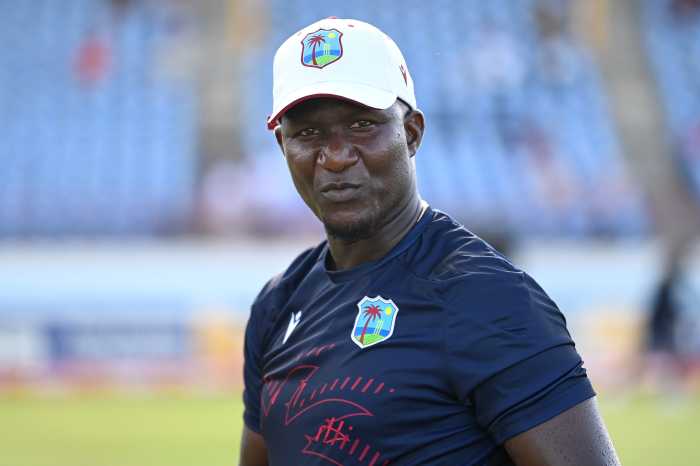Rainbow arches of balloons traveled down Fifth Avenue during the 2017 LGBTQ Pride Parade. | DONNA ACETO
While Heritage of Pride (HOP) is saying that community complaints prompted it to alter the route of New York City’s LGBTQ Pride Parade and move the events associated with the parade out of the West Village, the original impetus for shortening all parades in the city came from an NYPD effort to reduce the costs of policing those events.
“The mayor has made it clear that New Yorkers can’t afford a tax increase now, and we can’t take our eyes off the ball when it comes to keeping crime low,” Ed Skyler, a deputy mayor in the Bloomberg administration, told the Daily News in 2010 after the NYPD ordered all parades to cut their routes by 25 percent and keep their run times to five hours or less. “Reducing the length and duration of parades across the board is a sensible way to save money in tough economic times.”
Paul Browne, the NYPD’s chief spokesperson in 2010, told the Wall Street Journal then that the cuts would save the agency $3 million a year in police overtime costs.
In 2010, Bloomberg administration, NYPD launched effort to keep events to five hours
Last year’s Pride Parade lasted nine and a half hours. While the demand on HOP that the parade last five hours or less remains the same, no group or person is currently saying that the cost to the city of policing and cleaning up after the parade is the reason for or even part of the motivation for the changes.
This year, HOP shortened and reversed the parade route so it runs south on Seventh Avenue from Chelsea then east on Christopher and 8th Streets and then north again on Fifth Avenue to end at 29th Street. Contingents this year are limited to 200 people and the number of floats and vehicles has been reduced. HOP is expecting 41,000 marchers this year as opposed to 55,000 last year.
The post-parade pier dance, now called Pride Island, and fireworks were moved from the West Village to Pier 97 on the Hudson River at the end of 57th Street. PrideFest, which, like the parade, takes place on the last Sunday in June, has moved to University Place between 13th Street and Waverly Place from the West Village’s Abingdon Square area.
HOP has said that community complaints led to the changes, though 311 and 911 call records indicate that there were few complaints about last year’s Pride events. The changes did not result from efforts by Community Board 2, which includes the West Village.
At a May HOP meeting, Julian Sanjivan, who heads HOP’s March Committee, said that the NYPD’s head of counterterrorism would attend a June 5 town hall to discuss the changes with the broader community. That suggests that safety may have played some role. HOP has also said that the new route is a trial run for next year’s parade, which will mark the 50th anniversary of the 1969 riots that mark the start of the modern LGBTQ rights movement.
HOP began discussing the changes in a series of meetings with the NYPD, the Sanitation Department, and other city agencies in August 2017. HOP is a membership organization and most of its proceedings are open to the public, but it did not broadly advertise the changes until after the NYPD had selected the new march route from choices offered by HOP and the decision was final.
Out gay City Council Speaker Corey Johnson, whose district includes major portions of the parade route, including the West Village and Chelsea, told Gay City News he was not brought into any discussions of the changes.
The NYPD divides uniformed police overtime costs for events into two broad categories — planned-for events that have occurred for three consecutive years and unplanned for protests, storms, or natural disasters, according to the city’s Independent Budget Office (IBO). The NYPD saw significant growth in all overtime costs, including events, arrest processing, investigations, and various operations from 1996 through 2014 even as the number of uniformed officers declined.
Last year, the Pride Parade and related events incurred just under $3 million in uniformed police overtime costs and the National Puerto Rican Day Parade cost $3.7 million, according to the IBO. The 2016 Thanksgiving Day Parade cost $531,000, and the St. Patrick’s Day Parade cost $967,000 in 2017. There are sporting events and unplanned events, such as guarding Trump Tower during protests, in the city that incur overtime costs that are equal to or much greater than the costs incurred by the Pride Parade or the National Puerto Rican Day Parade.
A group of activists with deep ties to the LGBTQ and other movements organized under the rubric of the Reclaim Pride Coalition (RPC) have demanded, among a longer list of demands, that HOP provide an “honest and transparent explanation for the dramatic route change.” To date, the explanations have not satisfied the Coalition members.
“We know there was a small number of complaints that HOP said were received after the 2016 and 2017 Pride celebrations,” said Jake Tolan, a Coalition member, in a written statement. “RPC would like to know why such a small percentage of residents were able to vanquish the LGBTQ community from the traditionally LGBTQ-friendly West Village and why HOP, an organization supposedly dedicated to LGBTQ rights, acquiesced so readily to the demonization and banishment of our communities.”
HOP, the NYPD, and the mayor’s office will further explain the changes at a June 5 town hall meeting beginning at 7 p.m. to be held at the Lesbian, Gay, Bisexual & Transgender Community Center on West 13th Street.


















